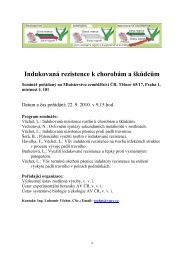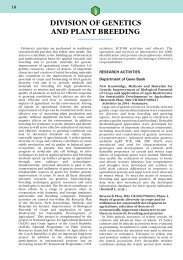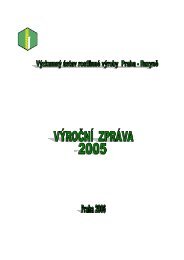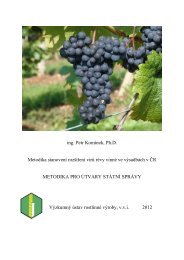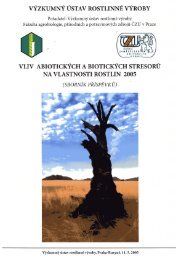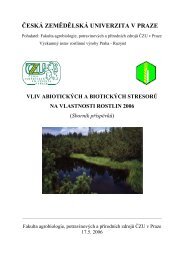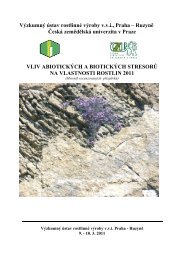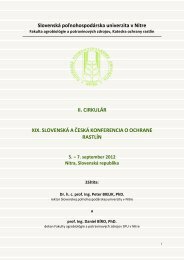00 ZLOM VURV 06 v roce 07
00 ZLOM VURV 06 v roce 07
00 ZLOM VURV 06 v roce 07
You also want an ePaper? Increase the reach of your titles
YUMPU automatically turns print PDFs into web optimized ePapers that Google loves.
27<br />
a preculture-desiccation method and deposited in the<br />
cryobank. Average plant survival in the tested potato<br />
cultivars after cryopreservation was 65% and average<br />
plant regeneration was 23%. The highest plant regeneration<br />
was 40% in cultivar ‘Oslava’ and the lowest<br />
10% in cultivars ‘Jara’ and ‘Rita’. On average, hop<br />
shoot tip survival was 70% and hop plant regeneration<br />
was 36%. The highest plant regeneration after<br />
cryopreservation was 60% in clone no. 71<strong>00</strong> and the<br />
lowest was 25% in clones no. 11772, 12847 and<br />
12859. The information about cryopreservation of<br />
individual genotypes was recorded into the Plant<br />
Genetic Resources Documentation Database. (Faltus<br />
M., Bilavãík A., Zámeãník J., Domkáfiová J.,<br />
Horáãková V., Ptáãek J., Svoboda P., Patzak J.,<br />
Nesvatba V.)<br />
Influence of abiotic stresses on the physiology<br />
of winter wheat sprouting plants<br />
(MZe âR QF 3056)<br />
The application of 24-epibrassinolide has a positive<br />
effect on the germination percentage in standard and<br />
also in stressed environment for sprouting plants – i.e.<br />
in the simulation of soil conditions with serial dehydration<br />
The application of 24-epibrassinolide has a substantial<br />
effect on the contamination of seeds by spores of<br />
fungi. The application of 24-epibrassinolide decreases<br />
the contamination by fungi in EBI and Estica while<br />
hardly any effect was found in Samanta. (Bláha L.,<br />
Hniliãka F., Kadlec P., Smrãková-Jankovská P.,<br />
Macháãková I., Sychrová E., Kohout L.)<br />
Dehydration and glassy state formation<br />
in biological objects (GA âR 522/04/0384)<br />
Theoretic and thermodynamic rules of glass formation<br />
in general as well as in biological systems were studied.<br />
Model state diagrams were drawn up for sucrose as the<br />
most widespread natural cryoprotective compound in<br />
biological samples and in cryoprotective mixtures. It<br />
was proved that the sucrose/water system freezes even<br />
during slow cooling to disequilibrium and during the<br />
heating of this system glass transitions, ice thawing and<br />
sucrose thawing appear. In the studied protein solution,<br />
water crystallization that probably relates to the<br />
antifreeze activity of protein was inhibited. Glass transitions<br />
and endothermic changes in biological samples<br />
could be separated by the combination of modulated<br />
differential scanning calorimetry, quasi-isothermal<br />
modulated differential scanning calorimetry, and<br />
differential scanning calorimetry with different heating<br />
rates, thermogravimetry and dilatometry. Based on the<br />
state diagrams, phase transitions were predicted and<br />
compared with the values measured in the range from<br />
–90° to -10° C in multicomponent plant systems<br />
(shoot tips of potato, hop, grapevine, garlic, and seeds of<br />
vegetables). Changes taking place in seeds during their<br />
storage at low temperatures were elucidated by the<br />
used thermal techniques. Different activation energies<br />
during the dehydration of vegetable seeds with<br />
different germination were found. Calorimetric<br />
measurements of apple buds help to define the formed<br />
biological glass and its stability during cryopreservation.The<br />
critical water content of dormant apple buds<br />
necessary for glass formation was 0.2 g H2O/g dry<br />
matter. At this dehydration level ice crystallization is<br />
prevented. (Zámeãník J., Bilavãík A., Faltus M.,<br />
Faberová I., Skládal V., ·esták J., Sikora A.,<br />
âerno‰ková E.)<br />
Study of the variability of Pyrenophora fungi<br />
in the Czech Republic (GA âR 521/<strong>06</strong>/1544)<br />
Every year leaf blotches on cereals cause considerable<br />
economic losses.The fungi of the genus Pyrenophora are<br />
among the causal agents. The aim of the project is to<br />
study the genetic variability of Pyrenophora teres and<br />
Pyrenophora tritici-repentis isolates obtained from different<br />
locations of the Czech Republic regarding their<br />
morphological and physiological characters. In 2<strong>00</strong>6,<br />
attention was paid to the ranking of isolates into races<br />
based on the presence of their so called toxin genes.<br />
The results showed that race 1 is dominant in the<br />
Czech Republic. The resistance of winter wheat<br />
and barley cultivars grown in the Czech Republic to<br />
P. tritici-repentis and P. teres was tested in greenhouse<br />
conditions. The variability of P. tritici-repentis isolates<br />
was studied on the DNA level using AFLP methodology.<br />
A low level of genetic diversity was found<br />
regardless of the race spectrum, considerable geographic<br />
distance (âR, SR, USA, Russia, Canada and<br />
Argentina) or year of collection.The results have been<br />
p<strong>roce</strong>ssed for publication. (Lei‰ová L., Udavská H.,<br />
Minafiíková V.)<br />
Exploitation of DNA arrays and bioinformatics<br />
in food safety studies (M·MT âR COST926<br />
1P05O54)<br />
Exploitation of high-throughput technologies for food<br />
safety and evaluation of the impact of health promoting<br />
compounds on human health. In the first year<br />
of the project in silico evaluation of the importance of<br />
health promoting compounds from Brassica species was<br />
done. Brassicaceae are valuable sources of health promoting<br />
compounds and may have remarkable impacts<br />
on public health. Parallelly a model experiment was<br />
conducted focused on the availability of model tissues<br />
or cells and modern technologies such as DNA arrays.<br />
We optimised RNA extraction and isolation from cell<br />
suspensions and their evaluation was done using DNA<br />
chips. The experiments will continue in 2<strong>00</strong>7.<br />
(Ovesná J., Mal˘ M., Svejkovská B.)<br />
Characterisation of genes encoding for<br />
enzymes participating in the biosynthesis<br />
of biologically active compounds<br />
(M·MT âR, 1P05O55 COST924)<br />
Bioavailability of health promoting compounds in<br />
plants (mainly in vegetables and fruits) is the main goal<br />
of Action COST 924.<br />
Within the project we studied the variability of the<br />
genes coding for enzymes involved in the biosynthetic<br />
pathway of ASCO (sulphur-containing amino acids).<br />
Sequences of aliinase, the key enzyme converting<br />
ASCO into biologically active compounds, were<br />
amplified, cloned and sequenced. Amplification products<br />
specific to four garlic genotypes were selected<br />
representing the basic types of garlic A. sativum var.<br />
sativum, A. sativum var. longiscupis and A. sativum var.<br />
ophioscordon, from different regions (Czech Republic,<br />
Austria and former Soviet Union) and periods of<br />
registration (old landrace, new cultivars). Sequencing<br />
revealed intron/exon variability. SNPs were identified




